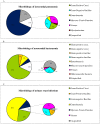Incidence of hospital-acquired pneumonia, bacteraemia and urinary tract infections in patients with haematological malignancies, 2004-2010: a surveillance-based study
- PMID: 23472145
- PMCID: PMC3589363
- DOI: 10.1371/journal.pone.0058121
Incidence of hospital-acquired pneumonia, bacteraemia and urinary tract infections in patients with haematological malignancies, 2004-2010: a surveillance-based study
Abstract
Objective: This study charted incidence trends of hospital-acquired (HA) pneumonia, bacteraemia and urinary tract infections (UTI) in a haematology department.
Methods: Prospective surveillance of hospital-acquired infections (HAI) was undertaken in a 42-bed haematology department of a university hospital. All patients hospitalized ≥48 hours between 1(st) January 2004 and 31(st) December 2010 were included. Definitions of HAI were based on a standardized protocol. The incidence was the number of events per 1000 patient-days at risk; only the first HAI was counted. Multivariate Poisson regression was fitted to assess temporal trends.
Results: Among 3 355 patients (58 063 patient-days at risk) included, 1 055 (31%) had HAI. The incidence of HA pneumonia, HA bacteraemia and HA UTI was respectively 3.3, 12.0 and 2.9 per 1000 patient-days at risk. HA bacteraemia incidence increased by 11% (95% confidence interval: +6%, +15%, P<0.001) per year, independently of neutropenia, central venous catheterization (CVC) and haematological disease. The incidences of HA pneumonia and HA UTI were stable. The most frequently isolated pathogens were Aspergillus spp. (59.2%) for pneumonia, coagulase-negative Staphylococcus (44.2%) for bacteraemia and enterobacteria (60%) for UTI.
Conclusion: The incidence of bacteraemia increased, indicating that factors other than CVC exposure, including chemotherapy with its impact on the immune system, could explain this trend. Further analytic studies are needed to explore the factors that could explain this trend.
Conflict of interest statement
Figures


Similar articles
-
Epidemiological study of secondary bloodstream infections: The forgotten issue.J Infect Public Health. 2019 Jan-Feb;12(1):37-42. doi: 10.1016/j.jiph.2018.08.011. Epub 2018 Sep 25. J Infect Public Health. 2019. PMID: 30266540
-
Incidence rates of hospital-acquired urinary tract and bloodstream infections generated by automated compilation of electronically available healthcare data.J Hosp Infect. 2015 Nov;91(3):231-6. doi: 10.1016/j.jhin.2015.05.011. Epub 2015 Jun 16. J Hosp Infect. 2015. PMID: 26162918
-
Point prevalence surveys on healthcare acquired infections in medical and surgical wards of a teaching hospital in Rome.Ann Ig. 2016 Jul-Aug;28(4):274-81. doi: 10.7416/ai.2016.2106. Ann Ig. 2016. PMID: 27479763
-
Hospital infection control in Italy.Infection. 2003 Dec;31 Suppl 2:4-9. Infection. 2003. PMID: 15018466 Review.
-
Staphylococcus aureus bacteraemia with known sources.Int J Antimicrob Agents. 2008 Nov;32 Suppl 1:S18-20. doi: 10.1016/j.ijantimicag.2008.06.006. Epub 2008 Aug 19. Int J Antimicrob Agents. 2008. PMID: 18715760 Review.
Cited by
-
Evaluation of New bioMérieux Chromogenic CPS Media for Detection of Urinary Tract Pathogens.J Clin Microbiol. 2015 Aug;53(8):2701-2. doi: 10.1128/JCM.00941-15. Epub 2015 May 20. J Clin Microbiol. 2015. PMID: 25994162 Free PMC article.
-
A New Scoring System for Predicting Mortality in Hematological Malignancies with Sepsis: A Derivation and Validation Study.Cancer Manag Res. 2023 Sep 29;15:1073-1083. doi: 10.2147/CMAR.S428930. eCollection 2023. Cancer Manag Res. 2023. PMID: 37794881 Free PMC article.
-
[Incidence of blood stream infections of 1265 patients with hematopoietic stem cell transplantation and analysis of pathogenic bacteria].Zhonghua Xue Ye Xue Za Zhi. 2017 Nov 14;38(11):930-933. doi: 10.3760/cma.j.issn.0253-2727.2017.11.005. Zhonghua Xue Ye Xue Za Zhi. 2017. PMID: 29224313 Free PMC article. Chinese.
-
Evaluation of antibiotic resistance, toxin-antitoxin systems, virulence factors, biofilm-forming strength and genetic linkage of Escherichia coli strains isolated from bloodstream infections of leukemia patients.BMC Microbiol. 2023 Nov 4;23(1):327. doi: 10.1186/s12866-023-03081-8. BMC Microbiol. 2023. PMID: 37925405 Free PMC article.
-
Failure mode and effects analysis-based strategies for controlling multidrug-resistant organism infections in cancer patients.Sci Rep. 2024 Nov 19;14(1):28564. doi: 10.1038/s41598-024-80282-9. Sci Rep. 2024. PMID: 39558037 Free PMC article.
References
-
- Thirumala R, Ramaswamy M, Chawla S (2010) Diagnosis and management of infectious complications in critically ill patients with cancer. Crit Care Clin 26: 59–91. - PubMed
-
- Bailey LC, Reilly AF, Rheingold SR (2009) Infections in pediatric patients with hematologic malignancies. Semin Hematol 46: 313–24. - PubMed
-
- Wisplinghoff H, Cornely OA, Moser S, Bethe U, Stützer H, et al. (2003) Outcomes of nosocomial bloodstream infections in adult neutropenic patients: a prospective cohort and matched case-control study. Infect Control Hosp Epidemiol 24: 905–11. - PubMed
-
- Velasco E, Soares M, Byington R, Martins CA, Schirmer M, et al. (2004) Prospective evaluation of the epidemiology, microbiology, and outcome of bloodstream infections in adult surgical cancer patients. Eur J Clin Microbiol Infect Dis 23: 596–602. - PubMed
-
- Gonzales-Barca E, Fernandez-Sevilla A, Carratala J, Salar A, Peris J, et al. (1999) Prognostic factors influencing mortality in cancer patients with neutropenia and bacteremia. Eur J Clin Microbiol Infect Dis 18: 539–44. - PubMed
MeSH terms
LinkOut - more resources
Full Text Sources
Other Literature Sources
Medical
Miscellaneous

